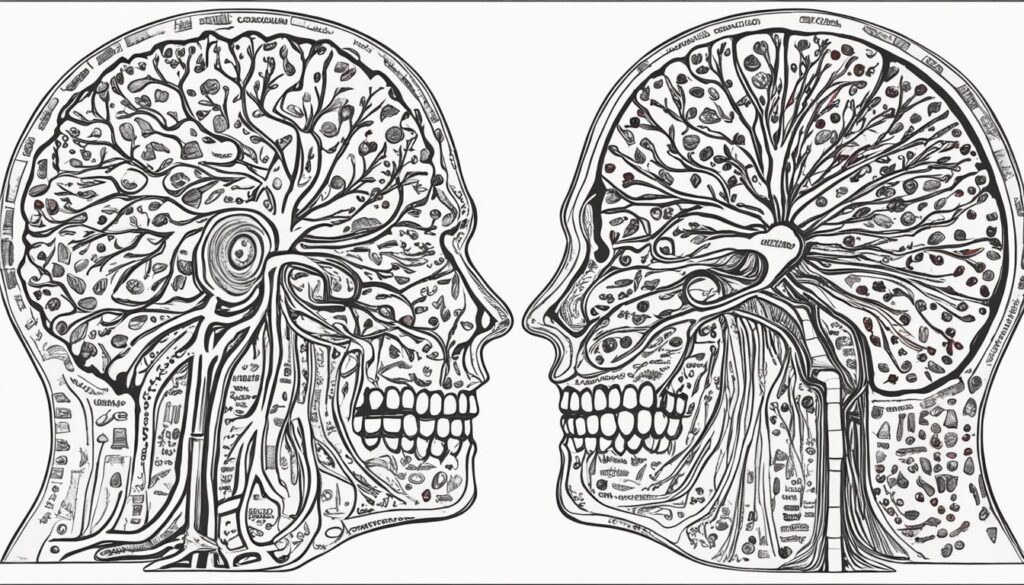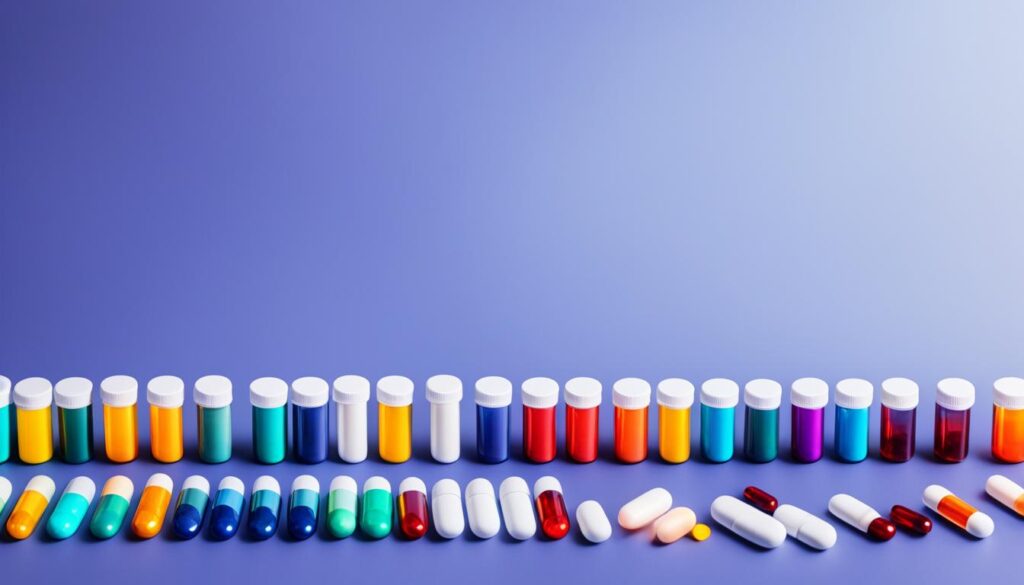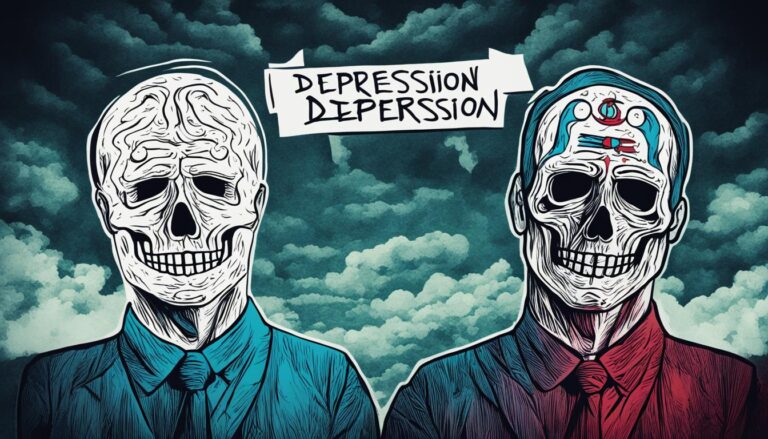It’s important to know the difference between depression and bipolar disorder for proper treatment. These two conditions share some symptoms but have different causes. Knowing the difference helps in choosing the right treatment, which is key for those affected.
Every year, over 17 million American adults deal with major depressive disorder. About 6 million face bipolar disorder. Depression usually starts in the late 20s, while bipolar disorder often begins in the mid-20s. This knowledge helps in finding the right treatment, improving life quality for those affected.
Key Takeaways
- Depression affects more than 17 million adults yearly, while bipolar disorder impacts about 6 million.
- Accurate identification of bipolar disorder is complicated due to the subtleties of manic episodes.
- Major depressive disorder is characterized by a single phase of depression.
- Bipolar disorder includes both manic and depressive phases and encompasses three main categories.
- Common medications like SSRIs are used for depression; mood stabilizers are often prescribed for bipolar disorder.
- Cognitive behavioral therapy is beneficial for both conditions, helping in emotional management.
- Understanding the timeline of symptom onset can aid in distinguishing between the two disorders.
What is Depression?
Understanding depression is key to seeing how it affects mental health. Major depressive disorder touches the lives of millions globally, causing ongoing sadness and a lack of interest in things we used to enjoy. This serious issue can mess with work, relationships, and overall happiness.
Defining Major Depressive Disorder
Major depressive disorder (MDD) is marked by deep emotional pain that makes daily life hard. People with mental health conditions like MDD often see big mood swings and feel unmotivated. To be diagnosed, one must have at least five of the usual symptoms of depression for over two weeks. These symptoms must be a big change from before.
Symptoms of Depression
The symptoms of depression can look different for everyone. But common ones include:
- Persistent feelings of sadness or low mood
- Loss of interest or pleasure in activities
- Significant changes in appetite or weight
- Sleep disturbances, such as insomnia or excessive sleeping
- Fatigue or loss of energy
- Feelings of guilt or worthlessness
- Difficulties with concentration and decision-making
- Suicidal thoughts or behaviors
Spotting these symptoms of depression is crucial for getting help. Getting the right treatment can really improve life quality.
What is Bipolar Disorder?
Bipolar disorder is a mental health condition that causes big mood swings. These swings can go from feeling very happy to feeling very sad. It usually starts in the teens or early twenties. It can also start later in life. Sometimes, it runs in families, which means it might be passed down from parents to children.
Understanding the Two Phases: Mania and Depression
There are two main phases of bipolar disorder: mania and depression. When someone is manic, they might feel very energetic, sleep less, and think a lot. They might also do things they wouldn’t normally do, like taking risks.
On the other hand, when someone is depressed, they might feel very down, tired, and not interested in doing things they used to enjoy. This is similar to what people with major depression feel.
Types of Bipolar Disorder
Bipolar disorder comes in different forms, each with its own level of mood swings. The main types are:
| Type | Description |
|---|---|
| Bipolar I Disorder | Defined by one or more manic episodes, which may be preceded or followed by hypomanic or major depressive episodes. |
| Bipolar II Disorder | Characterized by at least one major depressive episode and at least one hypomanic episode, without a full manic episode. |
| Cyclothymic Disorder | Involves periods of hypomanic symptoms and periods of depressive symptoms lasting for at least two years (one year for children and adolescents), but not meeting criteria for a major depressive episode. |
Knowing about the different types of bipolar disorder helps in spotting the symptoms and getting the right diagnosis. With the right treatment, like medicines and therapy, people with bipolar disorder can manage their mood swings. This helps them live a happy and fulfilling life.
Key Differences Between Depression and Bipolar Disorder
It’s key to know the differences between depression and bipolar disorder for the right diagnosis and treatment. The main difference is in their emotional range and how long and severe episodes can be. People with unipolar depression and those with bipolar disorder have different emotional experiences.
Emotional Range in Depression vs. Bipolar Disorder
Those with unipolar depression feel a deep sadness that lasts a long time. They don’t have the ups and downs seen in bipolar disorder. Bipolar disorder, on the other hand, brings big mood swings, from very high to very low.
This means depression is mostly about feeling sad all the time. Bipolar disorder adds sudden mood changes to the mix. This shows how different these two conditions are in terms of emotions.
Duration and Severity of Episodes
Depression episodes can go on for a long time. Bipolar disorder episodes can change quickly and vary a lot. Some people with bipolar disorder switch from feeling very high to very low in a short time.
This shows how depression and bipolar disorder are not the same. They affect people in different ways, both emotionally and physically.
Symptoms of Major Depressive Disorder
Major depressive disorder can really affect someone’s well-being. It brings a lot of distressing symptoms. These symptoms can deeply impact mental health, changing mood and life functioning. It’s important to recognize these symptoms early for support and help.
Common Symptoms Experienced
Symptoms of major depressive disorder may include:
- Persistent feelings of sadness
- Fatigue and lack of energy
- Difficulty concentrating
- Feelings of worthlessness or guilt
- Disruptions to sleep and appetite
These symptoms can show in different ways. It’s important for people and their families to know the signs. Knowing these signs can help those who need support.
Impact on Daily Life
Major depressive disorder has a big impact on daily life. People may find it hard to do everyday tasks. This can affect work, relationships, and overall happiness. Simple tasks become too much, leading to staying away from social activities and losing personal connections.
It’s crucial to tackle these issues early. Balancing hormones with exercise and good sleep is key to feeling better. For more tips on managing hormones, check out this resource.
Symptoms of Bipolar Disorder
Bipolar disorder has many symptoms that set it apart from other mood disorders. It’s important to know these symptoms to get the right treatment. About 3% of people in the U.S. have this condition. Knowing about manic and hypomanic episodes helps in spotting the disorder.
Identifying Manic and Hypomanic Episodes
Manic episodes are periods of high mood that last at least a week. They are marked by:
- Excessive energy and activity
- Rapid speech and racing thoughts
- Decreased need for sleep
- Engagement in risky behaviors
Hypomanic episodes are less intense and last four days or more. They have similar symptoms to mania but don’t severely affect daily life. Hypomanic episodes can still disrupt life and relationships, even if they’re not as intense as manic episodes. It’s key to know that depressive episodes in bipolar disorder can be similar to major depression. This can lead to wrong diagnoses, as 40% of people with bipolar depression might first be called major depression.
Mixed Episodes and Their Implications
Mixed episodes combine symptoms of mania and depression at the same time. These episodes make diagnosing bipolar disorder harder and raise the risk of suicide, especially in those with bipolar I disorder. Mixed symptoms bring more distress, making it crucial to get full support. Knowing the symptoms of bipolar disorder helps in finding the right therapy and medication for each episode type.
Understanding Depression vs. Bipolar Disorder
Depression and bipolar disorder are different in many ways. It’s key to know these differences for the right diagnosis and treatment. By understanding how moods change, last, and get intense, we can tell them apart.
Comparative Analysis of Symptoms
Depression symptoms last over two weeks and include feeling sad, having less energy, and not enjoying activities. Bipolar disorder, on the other hand, has mood swings from high energy to feeling down. These mood swings can last a week or more and are more extreme than in depression.
How to Distinguish Between Them
To tell depression from bipolar disorder, look for manic episodes and mood patterns. Bipolar disorder often brings high moods that lead to acting on impulse. Depression keeps a person in a low mood. The history of mood changes, how long they last, and their effect on daily life also help tell them apart.

Diagnosis of Depression
Diagnosing major depressive disorder is a careful process. It relies on specific criteria and symptoms. Mental health organizations provide guidelines for accurate diagnosis. With nearly three in ten adults experiencing depression, knowing how to diagnose is crucial.
Criteria for Diagnosing Major Depressive Disorder
Clinicians look for certain symptoms to diagnose major depressive disorder. These symptoms must last at least two weeks. They include:
- Persistent sadness or low mood
- Loss of interest or pleasure in activities
- Changes in appetite or weight
- Sleep disturbances
- Fatigue or loss of energy
- Feelings of worthlessness or excessive guilt
- Difficulty concentrating or making decisions
- Recurrent thoughts of death or suicide
For a diagnosis, individuals must show several of these symptoms. The disorder often starts in late teens to mid-20s. It affects younger adults more than older ones.
Diagnostic Tools and Assessments
Diagnostic tools are crucial for assessing mental health. Standardized questionnaires help measure symptoms’ severity and daily impact. These tools, along with medical histories, aid clinicians in choosing treatments.
The process includes initial evaluations and follow-ups. It helps track how well treatment works. With proper diagnosis, 70% to 90% of people with depression get better, showing the value of thorough assessments.
Diagnosis of Bipolar Disorder
Diagnosing bipolar disorder is tricky for doctors. Symptoms can be similar to other mood disorders, making it hard to tell them apart. This often leads to wrong diagnoses. To spot bipolar disorder, doctors need to look closely at a person’s mental health history and symptoms.
Challenges in Accurate Diagnosis
Diagnosing bipolar disorder is tricky for many reasons. Sometimes, manic or hypomanic episodes are missed, especially if someone mainly feels depressed. This can mean doctors don’t fully understand what’s going on. Also, having other conditions like anxiety or ADHD can make it harder to diagnose.
How long it takes to figure out the symptoms matters a lot. It’s important for doctors to watch for mood changes closely.
The Role of Life Charts in Diagnosis
Life charts are very helpful in diagnosing bipolar disorder. They track mood, sleep, and daily life over time. This gives doctors a clear picture of a person’s mental health.
By looking at these charts, doctors can tell the difference between mood states. This helps them spot manic or hypomanic episodes better. Life charts also help in making treatment plans by showing what triggers episodes and patterns.
Staying healthy and finding ways to manage anxiety is key to better mental health. For tips on managing anxiety, check out this guide.
| Type of Episode | Duration | Symptoms |
|---|---|---|
| Manic Episode | At least 7 days | Elevated mood, increased energy, decreased need for sleep |
| Hypomanic Episode | At least 4 days | Similar to manic but less severe |
| Depressive Episode | 2 weeks or more | Low mood, fatigue, loss of interest |
Treatment Options for Depression
Treating depression often means using a mix of strategies for the best results. People usually look at medications and therapy to help manage their symptoms.
Medications for Major Depressive Disorder
Here are some common medicines for major depression:
- Selective serotonin reuptake inhibitors (SSRIs): Examples include citalopram (Celexa), fluoxetine (Prozac), and sertraline (Zoloft).
- Serotonin-norepinephrine reuptake inhibitors (SNRIs): Notable options are duloxetine (Cymbalta) and venlafaxine (Effexor XR).
- Atypical antidepressants: Medications like bupropion (Wellbutrin) and mirtazapine (Remeron) may be helpful.
- Tricyclic antidepressants: Imipramine (Tofranil) and amitriptyline are examples in this category.
- Monoamine oxidase inhibitors (MAOIs): These include phenelzine (Nardil) and tranylcypromine (Parnate).
It’s important for patients to talk often with their doctors about how the medicines are working. They should also discuss any changes that might be needed. This is especially true because some medicines can make some people feel worse, especially the young.
Therapies and Counseling Approaches
Therapy is also key in treating depression. Good treatments often include:
- Cognitive Behavioral Therapy (CBT): This helps people change negative thoughts and behaviors linked to depression.
- Interpersonal Therapy: This type of therapy aims to improve relationships and social support.
- Psychoeducation: Teaching patients about their condition helps them understand and manage their symptoms better.
Using both medicines and therapy together works well for many people. It helps them recover and manage their depression better over time.
Treatment Options for Bipolar Disorder
Treatment for bipolar disorder is key to managing it well. It often includes both medication and therapy. The aim is to keep mood stable and reduce how often and how bad episodes get.
Medications Used in Bipolar Disorder Management
Medicines are a big part of treating bipolar disorder. Mood stabilizers like lithium and divalproex help with manic episodes. Antipsychotics, such as olanzapine and quetiapine, help with severe symptoms.
For depression, antidepressants are used carefully. They are often given with mood stabilizers to prevent manic episodes. Finding the right mix of medicines is an ongoing process.
The Importance of Mood Stabilizers
Mood stabilizers are crucial for bipolar disorder treatment. They keep emotions balanced and stop mood swings. Regular checks make sure these medicines still work well as symptoms change.
In severe cases, some might need electroconvulsive therapy (ECT). A good treatment plan includes mood stabilizers, therapy, and ongoing support.

Coping Strategies for Depression
Managing depression means finding ways to improve daily life and feel better emotionally. Using self-help techniques helps people take charge of their mental health. It’s key to build a support network for encouragement and strength during recovery.
Self-Help Techniques
Self-help is vital for dealing with depression. Here are some helpful strategies:
- Regular Exercise: Being active can make symptoms better and lift your mood.
- Healthy Eating: Eating well feeds your body and mind, helping your mental health.
- Establishing a Routine: Having a daily routine brings order and lessens chaos.
- Mindfulness and Meditation: These practices keep you in the moment and lower anxiety.
- Limiting Alcohol: Cutting down on alcohol is important for recovery as it can make depression worse.
Creating a Supportive Network
Having a supportive network is crucial for those with depression. Support can come from:
- Friends and Family: Being close to loved ones offers understanding and support.
- Support Groups: Being part of groups with others who understand helps you feel like you belong.
- Professional Help: Working with mental health experts gives you tools and advice for coping with depression.
| Self-Help Techniques | Benefits |
|---|---|
| Regular Exercise | Boosts mood and reduces anxiety |
| Healthy Eating | Supports overall mental health |
| Establishing a Routine | Creates stability and consistency |
| Mindfulness and Meditation | Helps manage negative thoughts |
| Limiting Alcohol | Reduces depressive symptoms |
Using these strategies can help people with depression find their way to recovery. Getting help and making connections can greatly improve life for those with depression.
Coping Strategies for Bipolar Disorder
People with bipolar disorder need to find ways to manage their symptoms and stay stable. Two key strategies are to follow routines and know the signs of mood changes.
The Role of Routine and Structure
Creating daily routines is very helpful for those with bipolar disorder. A structured life brings less uncertainty and helps with emotional control. It’s important to have regular sleep, exercise, and meal times.
Research shows that focusing on tasks is common among those with bipolar disorder. A study found that people with bipolar disorder scored higher in task-oriented coping than those with depression. This shows how effective this approach can be.
Recognizing Warning Signs
Knowing the early signs of mood shifts helps people act before things get worse. Look out for changes in sleep, appetite, and mood. Spotting these signs early can stop severe episodes of mania or depression.
Keeping a mood chart can help track feelings and behaviors. This can show patterns and what triggers mood changes. A study showed that keeping an eye on mood can lessen the impact of relapses.

| Warning Signs | Common Triggers | Coping Strategies |
|---|---|---|
| Changes in appetite | Stress | Talk to a supportive person |
| Sleep disturbances | Financial difficulties | Engage in physical exercise |
| Decreased concentration | Arguments | Participate in support groups |
| Social withdrawal | Seasonal changes | Maintain a crisis plan |
Support Resources for Depression and Bipolar Disorder
Getting the right support is key for those dealing with depression and bipolar disorder. Therapy offers both expert advice and emotional support. This is vital for handling the tough parts of these mental health issues. Groups like the American Psychiatric Association and the Depression and Bipolar Support Alliance help make sure people get the caring help they need.
Therapy and Counseling Services
Therapy is a big help in dealing with symptoms of depression and bipolar disorder. There are many places to find qualified mental health experts. The American Psychological Association and the Anxiety and Depression Association of America are great resources. They help people understand their conditions and find ways to cope.
Support Groups and Community Resources
Support groups create a strong community for people facing similar issues. Groups like the National Alliance on Mental Illness and the International Bipolar Foundation offer a place to connect and share. These groups help with recovery and spread awareness about depression and bipolar disorder in different communities.


